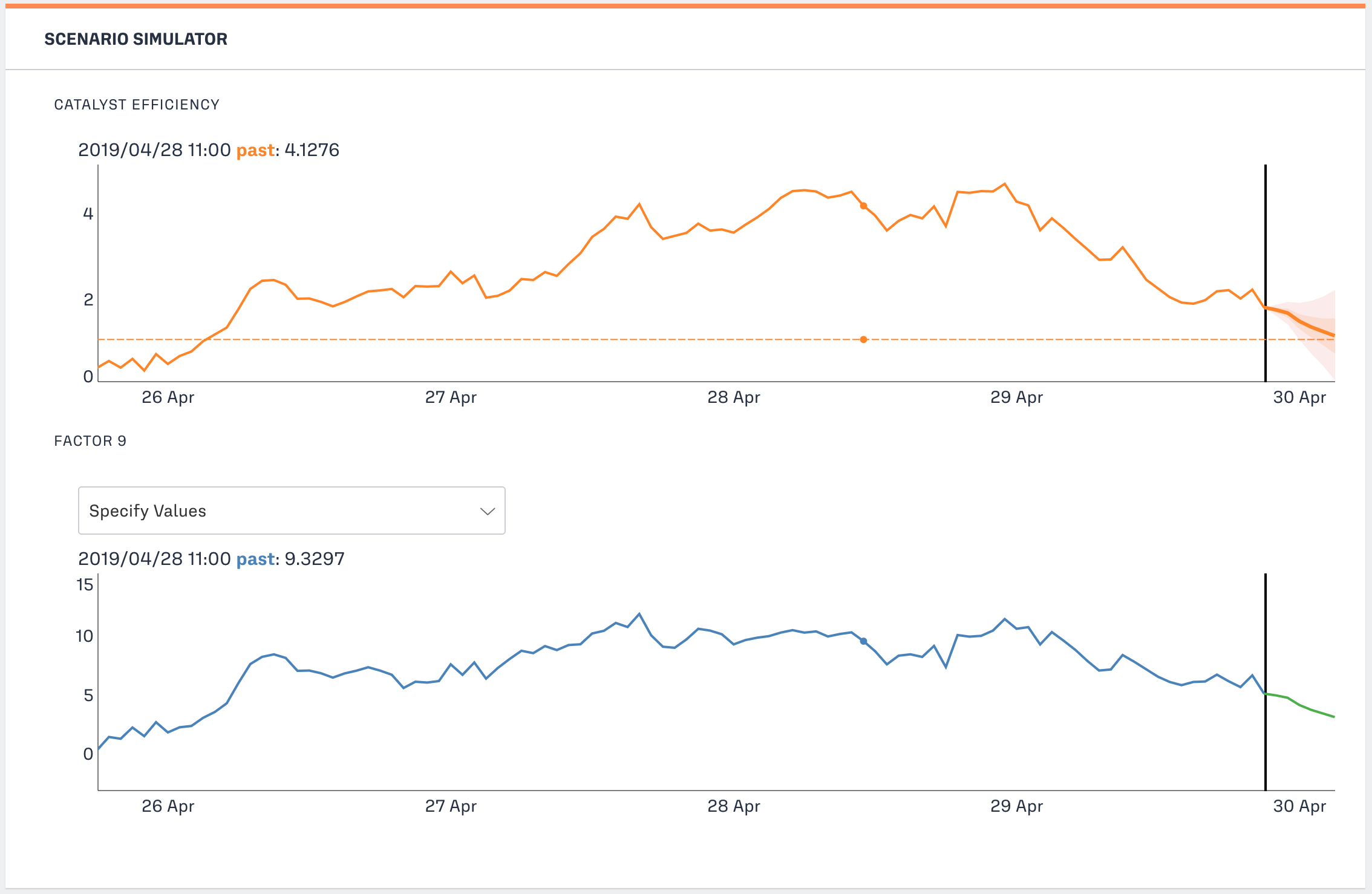Use Case Description
Background
Catalysts lower the activation energy for chemical reactions and are often necessary for feasible production at scale. In continuous process chemical production, catalysts progressively lose efficiency. Such catalyst deactivation may be measured in reaction temperatures, analytical product concentrations, and other metrics.
Forecasting catalyst deactivation rates enable operators to optimally regenerate/replace catalysts, avoiding unplanned downtime and maximizing profitability. Understanding the root cause of catalyst deactivation enables plants to make operating changes to prolong catalyst lifetime.
Problem
Gradual catalyst degradation is challenging to proactively manage because degradation rates are too complex to analyze with simple physics-based models. While direct and indirect measurements of catalyst efficiencies are available, they rarely suffice to provide actionable forecasts of catalyst health. Known degradation modes combined with highly dynamic operating conditions can lead to unexpected but predictable catalyst degradation.
Plant operators use data visualization and analytics software to monitor catalyst efficiencies. Changes in catalyst health prompt reactive actions. Early actions may lead to premature catalyst regeneration. Late actions may lead to unplanned downtime. Both increase costs.
Forecast catalyst efficiencies across varying process conditions and proactively address catalyst degradation to reduce costs and unplanned downtime.
In ideal conditions, catalyst consumption should be reversible and consistent. In practice, catalysts deactivate due to many reasons:
- Poisoning: The catalyst comes into contact with a poisoning agent, like sulphur, lead, phosphorous, or other kinds of agents depending on the catalyst. The poisoning agent binds irreversibly to the catalyst and prevents reactants from binding, which deactivates the catalyst. Poisoning events can occur suddenly due to contamination in reactant lines.
- Coking: Carbon buildup occurs on catalyst active sites, which can happen for a variety of reasons in petrochemical processes. The build up takes up space on the catalyst and therefore removes active sites from binding with reactants.
- Thermal degradation: Temperatures can warp the active sites of the catalyst, which changes their geometry and therefore effectiveness of binding to the necessary reagents. Thermal degradation is oftentimes irreversible.
- Transport loss: Under certain conditions, molecules present in reactant streams can bind with the catalyst in such a way that they can leech and remove the catalyst particle, and carry it off in the product stream. One such example is the formation of volatile metal carbonyls with CO in methanation reactions.
- Crushing: The catalyst can sometimes get physically crushed, which irreversibly destroys its active sites.
Fero Labs Solution
A virtual soft-sensor can be configured to predict and monitor the catalyst efficiency at a specific part of production. Fero’s machine learning technology can effectively incorporate progressive deactivation, such as coking, thermal degradation, and catalyst lost via transport.
By learning how historical process conditions relate to catalytic activity, Fero provides plant operators with forward-looking forecasts, that not only enable operators to monitor process conditions, but take action to get the most out catalysts as they inevitably deactivate over time.

Process & Business Outcomes
Increased profitability by extending catalyst lifetime
With the Fero Labs platform providing forecasts for catalyst degradation days in advance, process engineers and plant operators can proactively increase profitability by extending catalyst lifetime. Since process engineers and operators gain access to predictions as early as 5 days ahead of time, they can proactively adapt rather than react to catalyst degradation caused by dynamic process operating conditions
With a full adoption of Fero on the production line, plant operators can achieve up to 20% extension of catalyst lifecycles.
Commensurate Scope 3 reduction through reduced catalyst usage
Reducing catalyst consumption directly reduces the Scope 3 carbon footprint of chemical processes. Since Scope 3 accounts for the majority (70+%) of chemicals production, reducing catalyst usage leads to a commensurate 14% reduction in Scope 3 emissions. Fero Labs can provide reporting capabilities that directly track and account for this reduction.
Informed decision-making to mitigate unplanned shutdowns
Plant operators can be more confident when deciding to initiate an unplanned shutdown or make an operational change when catalyst degradation accelerates. Similarly, they can be more confident of when they achieve steady-state conditions and high catalyst activation.
With a full adoption of Fero Labs software, plant operators can expect to experience up to 36% decrease in unplanned production shutdowns and startups.
Fero Labs Adoption Timeline
Plant teams can collaborate to set up and deploy Fero Labs. Below is a timeline highlighting typical steps. With Fero’s easy-to-use, no-code interface, this can be achieved in a matter of weeks, not months or years.
Data Requirements
Plant teams can collaborate to set up and deploy Fero. Below is a timeline highlighting typical steps. With Fero’s easy-to-use, no-code interface, this can be achieved in a matter of weeks, not months or years.
Activating This Use Case
Consider our Industrial Use Case Playbooks as inspiration and tactical ideas for your team to align on to maximize the efficiencies of your plant.
Each Playbook has a matching Use Case Blueprint which provides more detailed steps to activate each use case within the Fero Labs platform.
If you’re curious to see these in action please book a free feasibility study with our team!
Together, let us continue to push the boundaries of what's possible, driving towards a future where industrial manufacturing is not just efficient and sustainable but truly transformative in its impact on society and the world at large.
Thank you for joining us on this journey, and we look forward to continuing to partner with you in your pursuit of excellence.
Download the entire Catalyst Lifecycle Optimization Use Case Playbook to access additional tables and details about this industrial use case.







